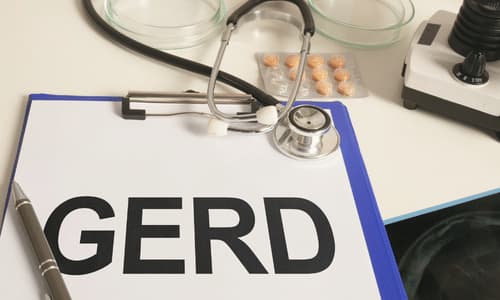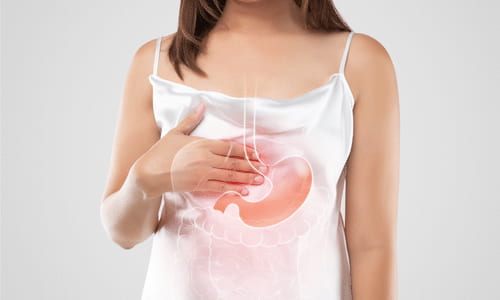The GERD Guide with GERD Diet Plan Menu PDF
“The GERD Guide with GERD Diet Plan Menu PDF” was written by Daria Zajac, RDN & edited/reviewed by Aly Bouzek, MS, RDN.
Have you noticed yourself reaching for the Tums bottle after your meals lately? Is that sour taste in your mouth starting to get bothersome? How about that urge to burp after enjoying your favorite tomato soup?
Friends, these are all familiar signs of GERD.
What is GERD, you ask?
GERD is a super uncomfortable condition that occurs after eating. This not only makes it less enjoyable to eat, but it can cause some serious damage if left untreated. Lucky for you, diet is one of the main lifestyle factors used to combat GERD.
So, let’s get right to it! If you’re too excited and want to jump in, then head to your FREE GERD Diet Plan Menu PDF now.
What is GERD?

You know that feeling right before you reach for the TUMS bottle, where you sense acid coming up your throat?
Yeah, that’s acid reflux.
When you eat, food passes from your mouth, through your esophagus, and then into your stomach.
The contents of the stomach sit there for about two hours, and then that mixture moves into your intestines and so on.
The digestive tract is meant to be a one-way street.
However, with GERD, that mixture gets pushed back up into your throat instead of down into the digestive tract, which is what causes undesirable symptoms (more on that later).
Everyone experiences acid reflux at one point in their life, but when this occurs more than 2-3 times a week, this is what we like (or don’t like) to call GERD (Gastroesophageal Reflux Disease).
Who is Affected by GERD?
GERD affects roughly 18.6 million people in the US, which is around 20% of the American population. (1,2)
The elderly are especially at risk for GERD complications because the typical signs of GERD may be confused for signs of other illnesses or even as side effects from medications. (2)
How is GERD Diagnosed?
In addition to having acid reflux more than 2-3 times a week, your doctor will ask you about additional symptoms you experience.
Based on these symptoms and medical history, the doctor will typically recommend two things:
- Lifestyle changes (exploring eating habits)
- Medications like an H2-blocker, proton-pump inhibitor, or even just taking an antacid (like TUMS) during a flare up
Doctors will diagnose GERD if these symptoms resolve with the use of medications and/or lifestyle changes. (1,3)
What Causes GERD?
GERD is one of the most common GI conditions in the US, but there is no one cause of GERD. (1) The cause of GERD can differ from person to person.
Let’s investigate further.
Risk Factors for GERD
Lifestyle behaviors that can increase the likelihood of acid reflux and GERD include (1):
- Age (older than 50 years old)
- Tobacco use
- Excessive alcohol use
- Trigger foods (discussed later)
- Eating late at night
- Certain medications
The Lower Esophageal Sphincter (LES) and Acid Reflux

The esophagus is like a slide.
Food slides down with the help of wave-like motions from our throat muscles.
When the food passes from the esophagus to the stomach, there is a slight narrowing at the bottom where the two meet.
This is called the lower esophageal sphincter (LES, for short). It acts as a gate between the esophagus and the stomach.
With frequent occurrences of acid reflux, this gate becomes weak and allows acidic content to push past the LES (when it’s not supposed to).
Over time, the acid exposure in the esophagus damages the esophageal tissue and can lead to conditions like Barrett’s Esophagus and cancer.
Obesity and GERD
The LES is in a unique spot in the body where there is lots of pressure. There needs to be a specific amount of pressure for the LES (AKA gatekeeper) to do its job.
But when there is a disruption in pressure, the LES cannot open/close correctly and the gate stays open.
Decreased Salivation
Weirdly enough, not having enough saliva can also contribute to acid reflux occurring.
Our saliva helps to move residue from our mouth down the esophagus when we eat or drink. It also helps neutralize any acid that is in the LES area.
With a decrease in saliva, we cannot effectively clear any leftover residue or neutralize acid in our throat, leaving us with a sour taste in our mouth (literally and figuratively).
Symptoms of GERD
While individuals diagnosed with GERD may have different symptoms, these are the most common (1,2):
- Burning sensation in throat (AKA heartburn)
- Chest pain
- Regurgitation
- Burping after meals
- Sour taste in mouth/throat
I have a GERD Diagnosis, Now What?
It can feel intimidating when you receive a medical diagnosis of any kind. It’s scary, and many times medical providers turn to medications as a first line of defense against GERD.
And while medications can be lifesavers in our day-to-day lives to alleviate symptoms of GERD, it’s also super important to review your diet and lifestyle behaviors that can further decrease bouts of acid reflux.
Let’s move on to GERD and our diet.
Diet and GERD Diet Plan Menu PDF
Diet, along with medications, is the first line of defense against GERD.
As we mentioned, certain foods can cause acid reflux to occur. Trigger foods can differ from person to person. For example, tomato soup may be a huge trigger food for you while someone else may have to avoid coffee or chocolate.
So while there is no “off limits” food list for someone with GERD, keeping a food journal to keep track of potential trigger foods and how they made you feel can help with meal planning.
Let’s talk about some of the foods and nutrients that help prevent GERD.
Fiber-Rich Foods

Fiber is a nutrient found in many grains, legumes, nuts, fruits, and vegetables.
High-fiber foods are recommended for those with GERD to help move food more easily in the digestive tract.
Fiber-rich foods reduce pressure on the LES and move contents out of the stomach quickly, leaving you acid-reflux free!
You’ll find plenty of great high-fiber foods in our GERD Diet Plan Menu PDF.
It’s recommended to consume 21-25 grams of fiber per day for women and 30-38 g per day for men.
Examples of high-fiber foods include:
Fats in Food
Fat is a macronutrient that our bodies need, even if some people don’t like to hear it!
Fat helps us protect our organs, absorb certain vitamins, and it supports many vital functions of the heart, brain, and eyes. That’s why it’s included in our GERD Diet Plan Menu PDF!

The two main types of fats include saturated and unsaturated.
Unsaturated fats are considered the “good” fats while the saturated fats are the ones we want to limit in our diet, especially when we have GERD.
Foods that are high in saturated fats tend to stay in our stomachs longer because they take longer to digest.
This means there is a greater chance for the contents of the stomach to push up against the LES.
A diet high in saturated fats also decreases the pressure of the LES, which again increases our chances of getting reflux.
Foods that are usually high in saturated fats include:
- Butter
- Lard
- Full-fat milks and cheeses
- Fried foods
- Palm oil and coconut oil
- Red meats like pork, beef, and lamb
- Poultry (with skin)
Here are some simple health tips to reduce your saturated fat intake:
- Take skin/marbling off of your foods to decrease fat content
- Instead of frying foods, try roasting or baking
- If you’re cooking, try swapping butter with extra-virgin olive oil or avocado oil
What Foods Should I Avoid with the GERD Diet Plan Menu PDF?
While these foods do not cause GERD, they can stimulate acid reflux and/or exacerbate GERD.
- Citrus fruits (like oranges and tomatoes)
- Certain vegetables (like onions, peppers, garlic)
- Spicy foods (jalapenos, hot salsas)
- Greasy/fried foods
- Carbonated beverages (pop, sparkling water)
- Caffeine (coffee, tea, chocolate)
- Alcohol
Some of these foods may land on your personal favorites list, and that’s OK.
If you or your loved one want to eat a trigger food, try to consume it earlier in the day with the addition of an antacid after your meal to avoid symptoms.
Additional GERD Diet and Lifestyle Tips for GERD Diet Plan Menu PDF
Diet and medications are crucial components of managing GERD. Your lifestyle behaviors also play a huge role not only with GERD, but your overall health.
Keep these tips in mind as you plan small changes in your daily routine:
- Eat smaller, more frequent meals
- Drink plenty of water between meals to clear residue
- Try not to lay down after eating (if you have to, elevate the head of your bead to 30 degrees)
- Avoid eating 3 hours before going to bed
- Try to reduce smoking if you smoke
- Avoid tight clothing
GERD Diet Plan Menu PDF
*Drum Roll Please*
To make things a little easier for you or your loved one, we have created a FREE 7-Day GERD Diet Plan Menu PDF. Just. For. You.
Eating healthy in general can be a hard skill to master, and with GERD, it can be even more difficult to figure out what foods to keep around and what foods to avoid.
With this simple meal plan, you can stop running through TUMS bottles left and right and start living a reflux-free life, knowing that you’ve kicked GERD to the curb!
The GERD Diet Plan Menu PDF Conclusion
GERD is a chronic form of acid reflux that can be alleviated with diet and lifestyle modifications.
Medications can also be used to treat symptoms.
So while there is no specific GERD diet, finding the foods, lifestyle behaviors, and medications that work best for you is key to living a reflux-free life.

GERD is a serious condition, especially one that interferes with one’s ability to do somethincag as simple as eating. Great insight shared!